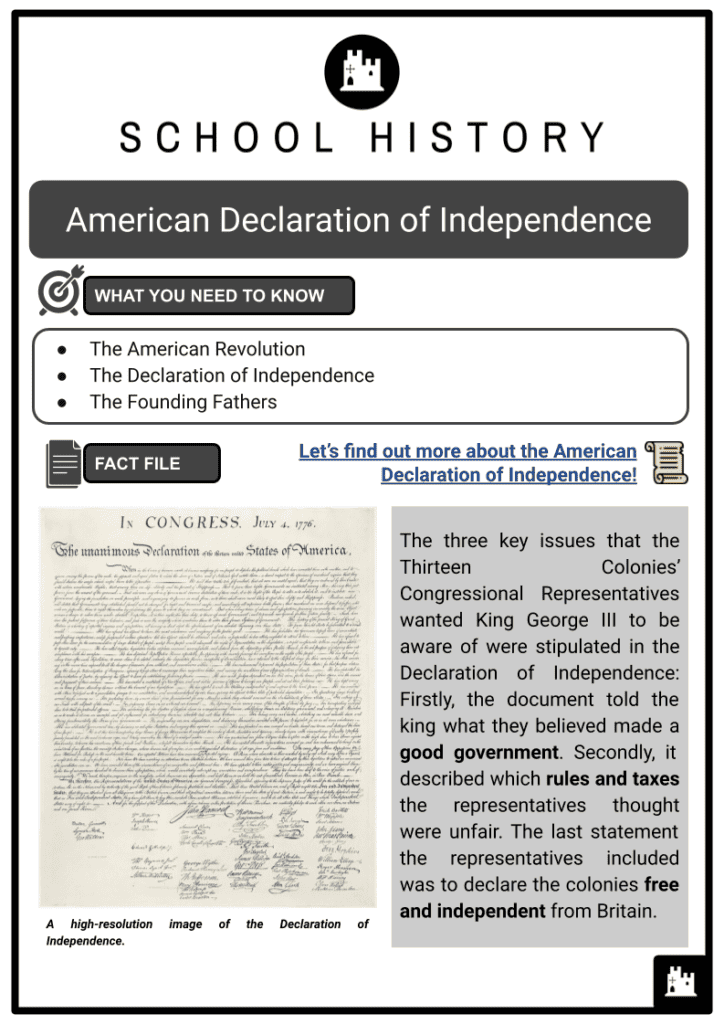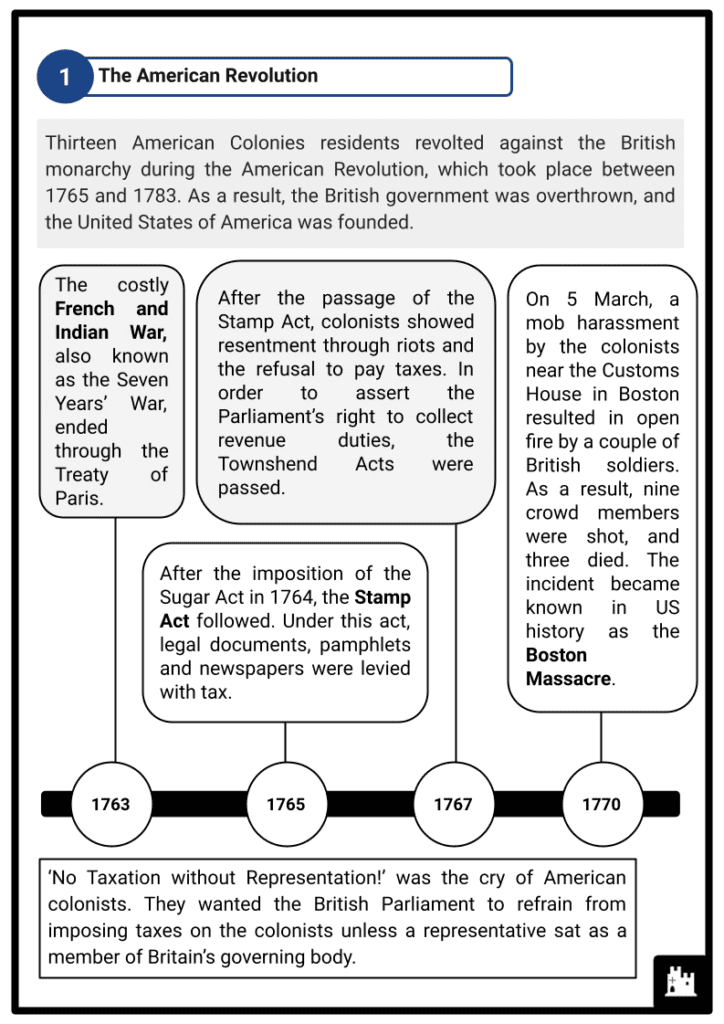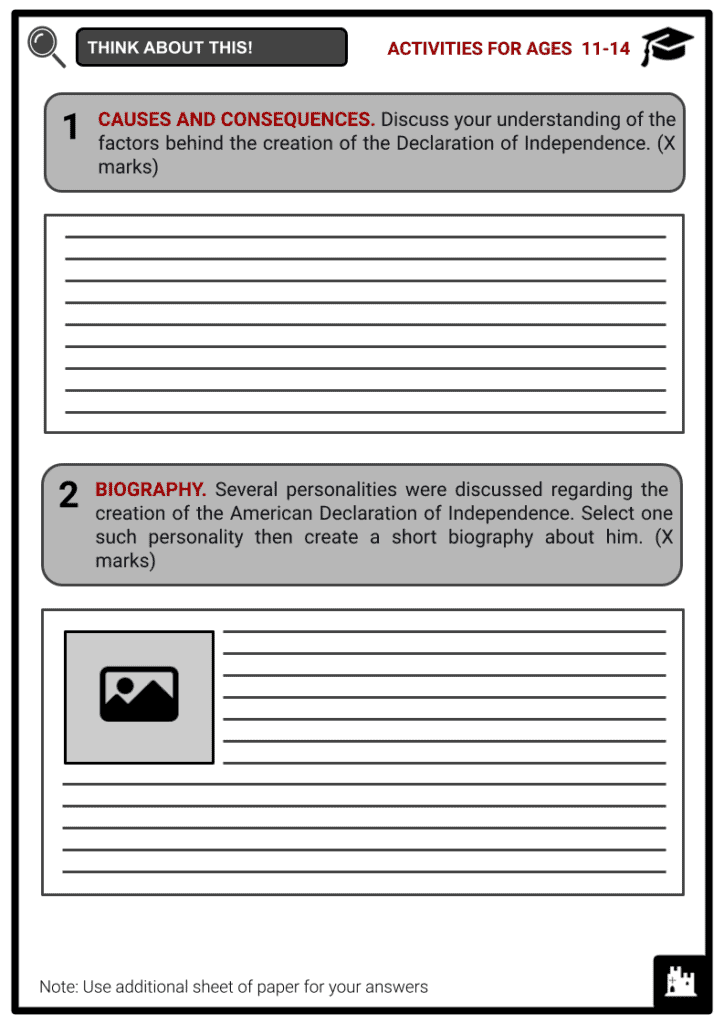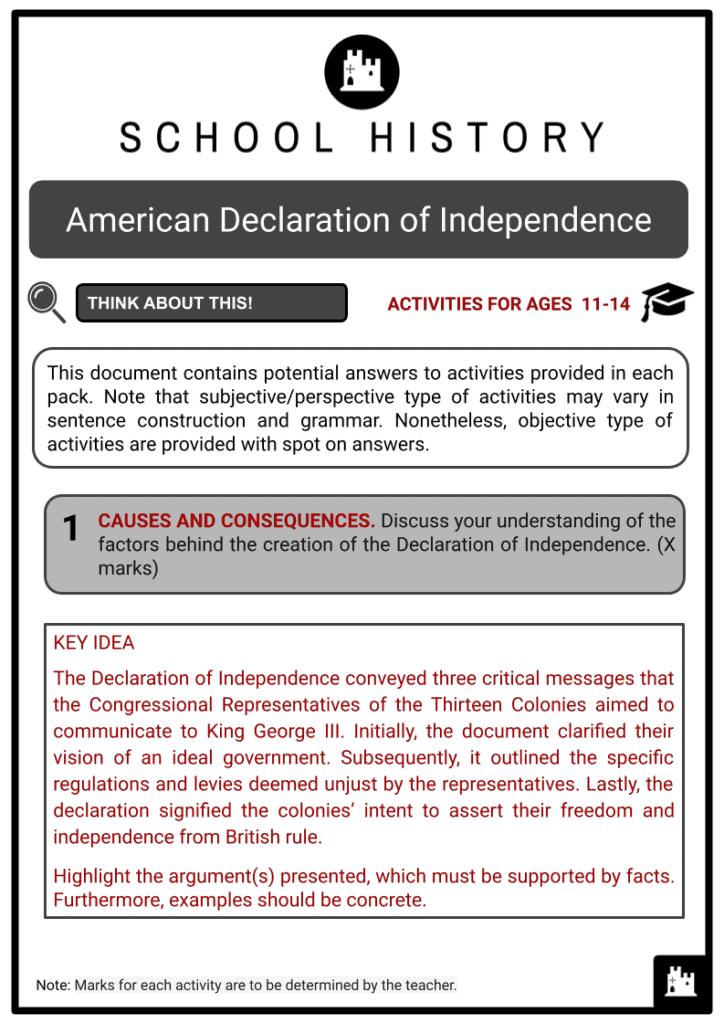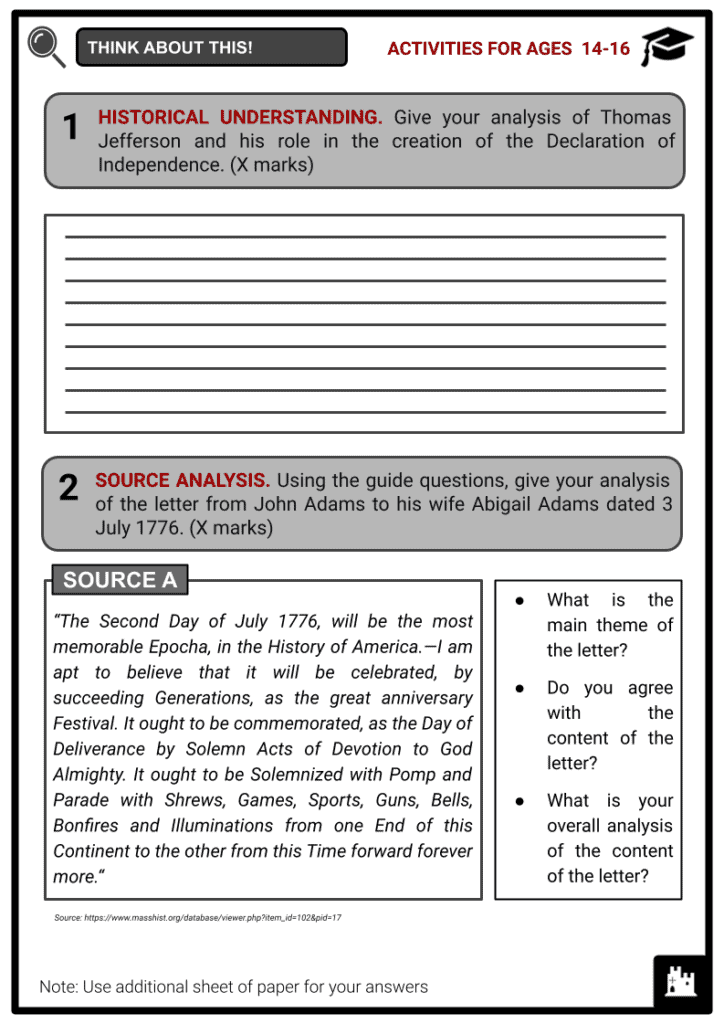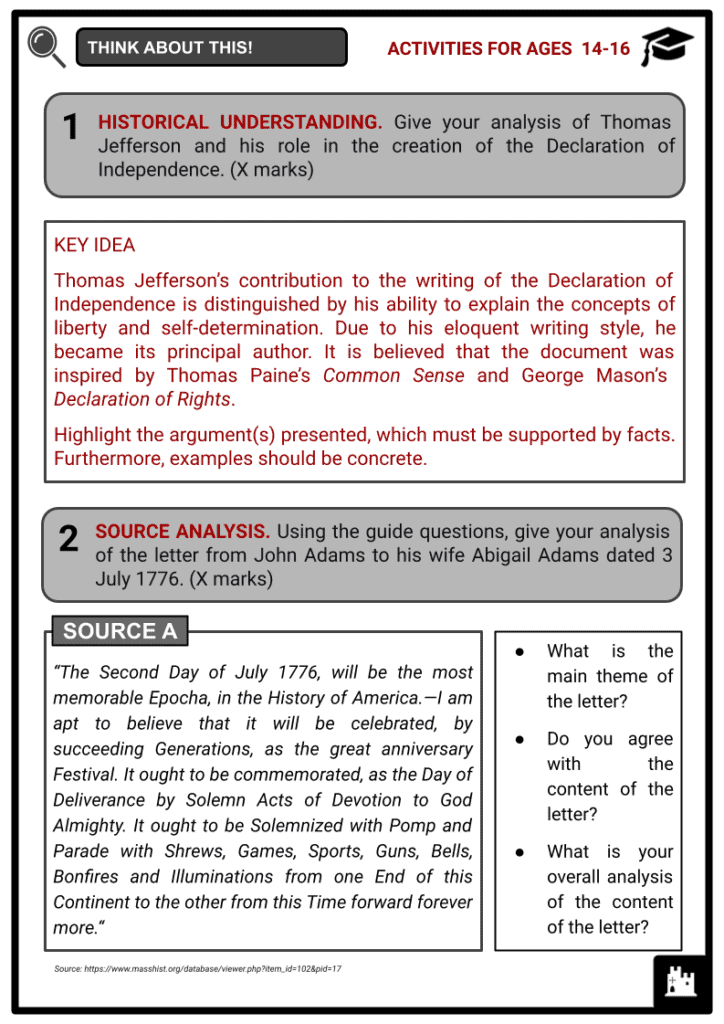American Declaration of Independence Worksheets
Do you want to save dozens of hours in time? Get your evenings and weekends back? Be able to teach about the American Declaration of Independence to your students?
Our worksheet bundle includes a fact file and printable worksheets and student activities. Perfect for both the classroom and homeschooling!
Summary
- The American Revolution
- The Declaration of Independence
- The Founding Fathers
Key Facts And Information
Let’s find out more about the American Declaration of Independence!
The three key issues that the Thirteen Colonies’ Congressional Representatives wanted King George III to be aware of were stipulated in the Declaration of Independence: Firstly, the document told the king what they believed made a good government. Secondly, it described which rules and taxes the representatives thought were unfair. The last statement the representatives included was to declare the colonies free and independent from Britain.
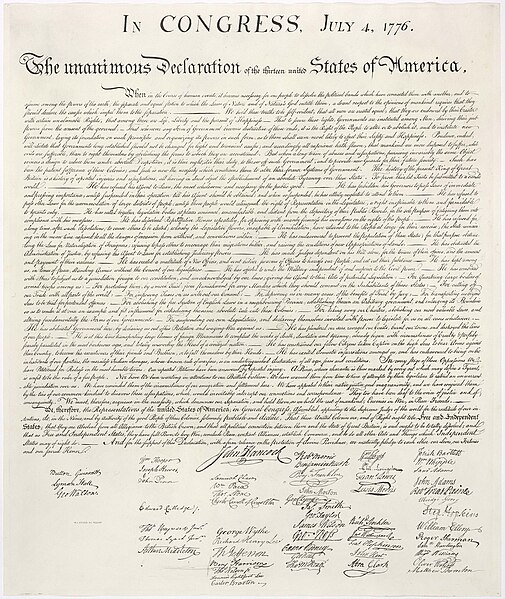
The American Revolution
- Thirteen American Colonies residents revolted against the British monarchy during the American Revolution, which took place between 1765 and 1783. As a result, the British government was overthrown, and the United States of America was founded.
- 1763. The costly French and Indian War, also known as the Seven Years’ War, ended through the Treaty of Paris.
- 1765. After the imposition of the Sugar Act in 1764, the Stamp Act followed. Under this act, legal documents, pamphlets and newspapers were levied with tax.
- 1767. After the passage of the Stamp Act, colonists showed resentment through riots and the refusal to pay taxes. In order to assert the Parliament’s right to collect revenue duties, the Townshend Acts were passed.
- 1770. On 5 March, a mob harassment by the colonists near the Customs House in Boston resulted in open fire by a couple of British soldiers. As a result, nine crowd members were shot, and three died. The incident became known in US history as the Boston Massacre.
- ‘No Taxation without Representation!’ was the cry of American colonists. They wanted the British Parliament to refrain from imposing taxes on the colonists unless a representative sat as a member of Britain’s governing body.
INCIDENT IN BOSTON
- On 5 March 1770, a group of protesters called the Patriots gathered at the Customs House in Boston and began protesting against the presence of British troops in the city for the enforcement of taxation measures. Ordered by their captain, Thomas Preston, British troops guarded the Customs House.
- After the incident, British soldiers were put on trial. In December 1770, two British soldiers were found guilty of manslaughter. As a result of the incident, the Sons of Liberty urged for the removal of British troops in Boston. It was Paul Revere, a patriot and member of the Sons of Liberty, who made the provocative engraving of the incident named by the Americans as the Boston Massacre. The British referred to it as the Incident on King Street. The engraving was disseminated throughout the colonies, which further reinforced colonists’ resentment of British rule.
- 1773. In protest at the tax on tea and the monopoly of the East India Company, a number of Bostonians disguised as Mohawk people boarded British merchant ships at anchor and dumped chests of tea into the harbour. It became known as the Boston Tea Party.
- 1774. In retaliation for the actions of colonists in Boston, the British Parliament passed the Coercive Acts, also known as the Intolerable Acts. They included the following: The Boston Ports Act, Massachusetts Government Act, Administration of Justice Act, and Quartering Act.
- In September, in response to the Intolerable Acts, all colonies except Georgia sent delegates to the First Continental Congress that convened in Philadelphia.
BOSTON TEA PARTY
- As part of the protest against the Tea Act of 1773, a group of colonists in Massachusetts disguised as Mohawk Indians boarded merchant ships full of chests of tea and dumped them all into the harbour.
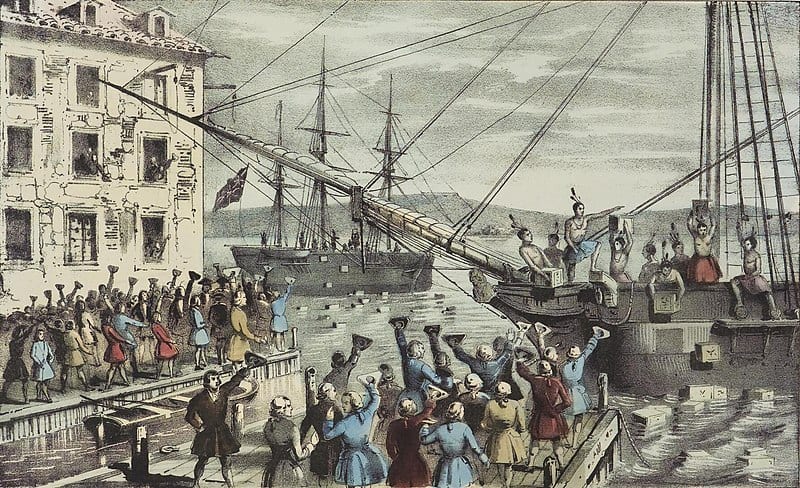
A painting by Nathaniel Currier entitled 'The Destruction of Tea at Boston Harbor', 1846. - On 16 December, the raid was organised by Samuel Adams with about 60 members of the Sons of Liberty, after Thomas Hutchinson, Massachusetts Governor, refused to give in to the colonists’ demand to halt three tea ships from docking in the harbour. In response to the destruction of millions of dollars worth of British tea, the Intolerable Acts, also known as the Coercive Acts, were passed in 1774.
The Declaration of Independence
- The colonists were frustrated with King George III and Britain. The men of the Second Continental Congress wanted to inform the king of how people were feeling, and what they wanted done about it. Five men were selected to write a letter to King George III. Four of the men were from the northern colonies. They were John Adams, Benjamin Franklin, Robert Livingston and Roger Sherman. One man, Thomas Jefferson, from the southern colony of Virginia, was asked to write the actual document due to his commended writing skills.
- The Declaration of Independence included three key points that the Thirteen Colonies’ Congressional Representatives wanted King George to know. Firstly, the document explained to the monarch what they considered to be good government. Secondly, it stated which rules and levies the representatives believed were unjust. The representatives’ last statement was to declare the colonies free and independent of Britain.
- Due to his eloquent writing style, Jefferson became the principal author of the Declaration of Independence. It is believed that the document was inspired by Thomas Paine’s Common Sense and George Mason’s Declaration of Rights. On 28 June, Jefferson submitted a draft of the document, which was accepted by Congress after a two-day debate and revisions.
KEY POINTS
- The Declaration’s introduction and background information are provided in the first section of the document. It affirms that when a government infringes on the rights of its citizens, it is their duty and right to overthrow the government and create a new one.
- The Declaration proclaims that every person possesses inherent and unalienable rights, including life, liberty and the pursuit of happiness. These rights are considered fundamental and cannot be revoked by any government:
“We hold these truths to be self-evident, that all men are created equal, that they are endowed by their Creator with certain unalienable Rights, that among these are Life, Liberty and the Pursuit of Happiness.”
- It asserts that the fundamental role of government is to safeguard these. The people that government serves are the source of its power. It states that protecting these rights is the primary responsibility of the state, and that the agreement of the governed confers legal authority on governments.
- There is a list of specific grievances against King George III and the British government in the pamphlet. These include oppressive and unfair practices like taxing without representation. It describes which rules and taxes the representatives thought were unfair.
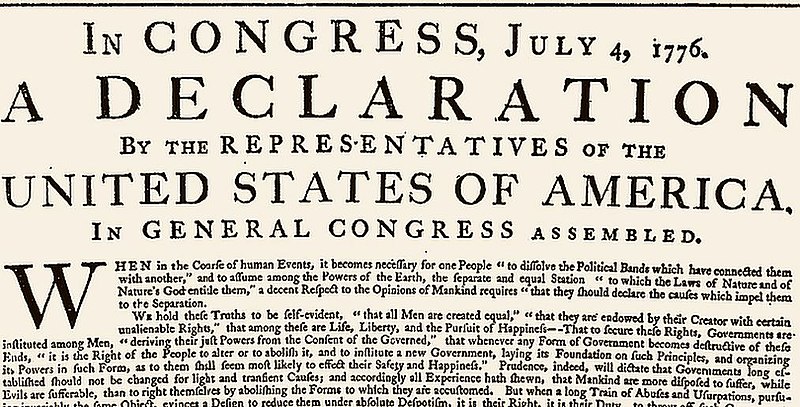
Original printing of the Declaration of Independence. - The Declaration’s conclusion is a formal statement pronouncing the independence of the Thirteen American colonies from British rule, confirming their status as sovereign and self-governing states.
- Essentially, the Declaration of Independence declared war on King George III and Great Britain. The document was signed by the Congressional Representatives of the Thirteen Colonies on 4 July 1776.
- As the Declaration of Independence spread in the colonies, it roused support for the American Revolution. The document particularly emphasised individual rights and self-government.
- 1778. On 6 February, France made an alliance with the American revolutionaries. Through the Treaty of Amity and Commerce and the Treaty of Alliance signed in Paris, France began to send fleets and armies.
- 1781. Between September and October, the Siege of Yorktown took place. With the French alliances, Washington’s troops won over British General Cornwallis. On 19 October 1781, Cornwallis and his troops surrendered.
- Crafted by the Second Continental Congress, the Articles of Confederation were adopted by the Congress in 1777 and ratified in March 1781.
- 1783. On 3 September 1783, the Treaty of Paris formally ended the American Revolutionary War.
The Founding Fathers
- The success of the American War of Independence was highly regarded by the Founding Fathers who are believed to have united the original thirteen colonies to fight against British rule. Most members were wealthy landowners and businessmen.
- GEORGE WASHINGTON
- During the French and Indian War, Washington fought for the British. He was a wealthy Virginian plantation owner and enslaver who began to resent the British Crown due to the imposition of taxes on the colonies. In 1775, he was appointed as the commander of the Continental Army by the Congress. Following the end of the war, Washington became the first president of the United States of America.
- ALEXANDER HAMILTON
- Born as an illegitimate son, Hamilton struggled in his early years. As a teenager, he emigrated to New York from the British West Indies and served as an aid to Washington during the Revolutionary War. In 1787, he wrote the Federalist Papers and pushed for the Constitution’s ratification. Under Washington, he served as the first secretary of the US treasury and created the national bank.
- BENJAMIN FRANKLIN
- Also known as an inventor, scientist, printer and diplomat, Franklin was appointed as one of the five members of the Committee of Five. Moreover, he was the main negotiator who sealed the alliance with France during the war and the Treaty of Paris in 1783.
- JOHN ADAMS
- Along with Franklin, John Adams served in the Committee of Five and negotiated the Treaty of Paris. In 1788, after diplomatic roles, Adams became Washington’s vice president for two terms. In 1797, he was elected as the second president of the United States.
- SAMUEL ADAMS
- Cousin of John Adams, Sons of Liberty leader, Samuel Adams most likely planned the 1773 Boston Tea Party. In 1775, the attempted arrest of Adams might have sparked the Battles of Lexington and Concord. After the war, he served as governor of Massachusetts.
- THOMAS JEFFERSON
- Virginian lawyer, Thomas Jefferson primarily drafted the Declaration of Independence in 1776 and wrote the phrase that ‘all men are created equal’. He served as Washington’s Secretary of State. In 1801, he was elected as the third president of the United States.
- JAMES MADISON
- Also from Virginia, Madison, who participated in the 1787 Constitutional Convention, drafted the US Constitution that stipulated the division of federal power into three branches. Known as the Father of the Constitution, Madison co-authored the Federalist Papers. In 1808, he served as the fourth president of the United States after being Jefferson’s secretary of state.
- ROBERT LIVINGSTON
- Robert Livingston was an American lawyer and diplomat. He was also one of the Committee of Five accountable for drafting the Declaration of Independence and played a significant role in the Louisiana Purchase.
- ROGER SHERMAN
- Roger Sherman was one of the Committee of Five accountable for drafting the Declaration of Independence. He was well known for the ‘Connecticut Compromise’, which defined the legislative structure of the US Congress.
- Other prominent figures included: John Jay, a lawyer and diplomat who also negotiated for the Treaty of Paris and served as the first chief justice of the Supreme Court; John Hancock, who served as the president of the Continental Congress; Thomas Paine, author of the influential Common Sense; Paul Revere, member of the Sons of Liberty known for his midnight ride; and Patrick Henry, a patriot known for his Give me liberty or give me death speech. Four of the original Founding Fathers became presidents of the United States of America. Most were also enslavers.
Frequently Asked Questions
- What is the purpose of the Declaration of Independence?
The Declaration of Independence announced the thirteen colonies' decision to break away from British rule, declaring their independence and asserting their natural rights to life, liberty, and the pursuit of happiness.
- Who wrote the Declaration of Independence?
Thomas Jefferson, with input from John Adams, Benjamin Franklin, Roger Sherman, and Robert R. Livingston, drafted the Declaration of Independence.
- What phrases from the Declaration of Independence are particularly famous?
The phrases "We hold these truths to be self-evident, that all men are created equal" and "Life, Liberty, and the pursuit of Happiness" are among the most famous lines from the Declaration of Independence, emphasising the principles of equality and individual rights.

